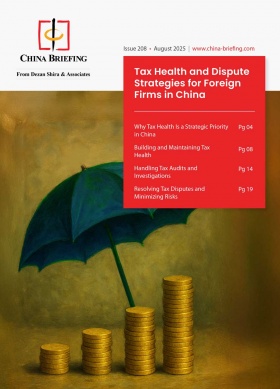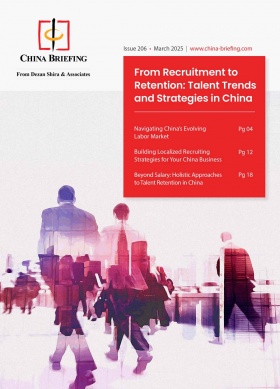China’s Provincial Economic Data in H1 2025: Which Regions Are Powering Growth?
China provincial GDP growth data from all 31 mainland regions in H1 2025 provides a detailed view of the country’s economic momentum, revealing both fast-growing provinces and those experiencing slower expansion. The results highlight shifting regional dynamics across sectors such as industry, services, and trade, offering clues to emerging growth engines and potential headwinds as China navigates the second half of the year.
All 31 of China’s mainland provinces, autonomous regions, and municipalities (hereinafter referred to collectively as “provinces”) have released their GDP and trade data for the first half of 2025, offering the most complete snapshot yet of the country’s economic performance this year. With national growth on track to meet government targets, these provincial releases highlight both the areas of strong momentum and those facing slower expansion, reflecting the diverse economic landscape across China’s regions. From industrial hubs and coastal exporters to central and western provinces, the data reveal how different sectors are contributing to overall growth.
The provincial data also shed light on broader trends shaping China’s economy. While some regions are benefiting from rising internal demand, investment, and trade, others continue to navigate structural adjustments and shifts in key sectors. We look at emerging growth centers and discuss the challenges and opportunities that may influence China’s economic trajectory in the second half of the year.
Overview of China’s 2025 H1 provincial GDP growth
China’s average year-on-year GDP growth rate in the first half of 2025 was 5.3 percent, with total GDP reaching RMB 66.05 trillion (US$9.24 trillion). This growth rate puts the country firmly on track to meet its annual GDP target of “around 5 percent” for 2025.
The provinces with the highest growth rates in the first six months of 2025 were Tibet, Gansu, and Hubei, all of which exceeded China’s national GDP growth rate. These provinces were also among the top four fastest-growing provinces in 2024.
Tibet remained the fastest-growing province with a 7.2 percent year-on-year increase. This reflects its relatively less developed economic status, which leaves more room for rapid expansion as investment and economic activity scale up. In H1 2025, the autonomous region benefited from growth across all three major economic sectors, with agriculture expanding particularly rapidly at a rate of 12.5 percent from the same period in 2024.
Meanwhile, the secondary industry grew 7 percent, with the added value of industrial enterprises with an annual main business income of over RMB 20 million (US$2.78 million) up 14.8 percent year-on-year. The tertiary sector rose 6.9 percent, buoyed by the expansion of tourism, trade, and public services. Tourism in particular has become an increasingly important driver of Tibet’s economy, with total tourism expenditure reaching RMB 31.55 billion (US$4.4 billion) in the first six months of 2025, up 10.2 percent year-on-year.
Gansu’s 6.3 percent GDP growth was powered primarily by its manufacturing sector, which expanded 12.7 percent year-on-year. This surge was reinforced by double-digit growth in several heavy and processing industries, including non-ferrous metal smelting and rolling (28.1 percent), electricity and heat production and supply (12.5 percent), pharmaceutical manufacturing (10.4 percent), and non-metallic mineral products manufacturing (10.3 percent). The province’s strong industrial base, coupled with demand for energy and materials, provided the bulk of its economic momentum.
Hubei, with 6.2 percent GDP growth, drew strength from a combination of robust industrial and service sector expansion. Manufacturing output rose 8.7 percent, led by rapid increases in high-tech manufacturing such as electrical machinery (18.8 percent), electronics (14.5 percent), and non-ferrous metals (19 percent). High-tech manufacturing overall grew 14.4 percent, with surging production of lithium-ion batteries (62.1 percent) and electronic components (53 percent).
Hubei’s services sector increased 6.4 percent year-on-year, with double-digit growth in transport, warehousing, internet services, and business leasing.
Overall, 21 provinces exceeded their GDP growth targets in the first half of 2025, while 22 surpassed the national average of 5.3 percent.
The regions with the slowest growth rates were Hainan (4.2 percent), Guangdong (4.2 percent), Qinghai (4 percent), and Shanxi (3.8 percent). Hainan, which has set a target of 6 percent growth for 2025, has seen slowing growth in recent years due to a combination of structural adjustments, changing external conditions, and slowing services activity. The services sector growth in particular has slowed, dropping from 10.3 percent year-on-year growth in 2023 to 3.6 percent in 2024 and 3.7 percent in the first half of 2025.
In tourism, the post-COVID reopening of outbound travel has led to increased competition from other destinations, particularly in Southeast Asia, which is attracting more Chinese travelers. Domestically, Hainan continues to transitioning away from a reliance on agriculture, real estate, and tourism while developing higher-value modern services and high-tech industries. This structural shift, occurring amid a more uncertain global economic environment, has contributed to a period of slower growth.
Shanxi has similarly seen slower growth in recent years. While it’s GDP growth rate in H1 2025 falls below its annual target of 5 percent, it is nonetheless a notable improvement from the 2.3 percent growth recorded in 2024. While all three industrial sectors saw positive growth, both the secondary and tertiary sectors expanded at relatively moderate paces of 3.7 percent and 3.8 percent, respectively, reflecting steady industrial and services activity.
China’s largest provinces in terms of economic output remain unchanged. By total GDP, Guangdong is still the single largest province with a GDP of RMB 6.87 trillion (US$956.9 billion), despite its relatively modest 4.2 percent growth rate. It is followed by Jiangsu (RMB 6.69 trillion / US$932.4 billion), Shandong (RMB 5 trillion / US$696.2 billion), and Zhejiang (RMB 4.5 trillion / US$626.5 billion).
Exports drive resilience, but uneven provincial trends emerge
China posted surprisingly strong national trade data in the first six months of 2025, defying major headwinds from the US’s ongoing trade onslaught. Total trade grew 2.9 percent year-on-year to RMB 21.79 trillion (US$3 trillion), with exports rising 7.2 percent to RMB 13 trillion (US$1.8 trillion). However, imports fell by 2.7 percent year-on-year to RMB 8.79 trillion (US$1.2 trillion). Much of the resilience came from higher exports to Southeast Asia countries in particular, as well as other Belt and Road markets.
At the provincial level, Guangdong remained the country’s largest trading province, recording RMB 4.6 trillion (US$640.5 billion) in total trade. Curiously, exports from Guangdong grew at a relatively slow 1.1 percent year-on-year, reaching RMB 2.9 trillion, while imports jumped 9.5 percent to RMB 1.66 trillion (US$231 billion). This likely reflects strong demand for resources to fuel the province’s huge manufacturing base.
Jiangsu (RMB 2.81 trillion / US$391.1 billion, up 5.2 percent), Zhejiang (RMB 2.73 trillion / US$379.9 billion, up 6.6 percent), and Shanghai (RMB 2.15 trillion /US$299.2 billion, up 2.4 percent) rounded out the top four provinces by trade volume. These eastern coastal provinces all reported double-digit export growth, but posted negative import growth, which may indicate weaker internal demand.
In year-on-year percentage terms, the fastest-growing provinces were Qinghai and Gansu. However, since both have very small absolute international trade volumes, relatively small changes in shipments can translate into large percentage swings.
Among provinces with both significant trade exposure and rapid growth, Hubei stood out. Its total trade grew 28.4 percent year-on-year to RMB 402.3 billion (US$56 billion) in the first six months of 2025. Of this, exports grew 38.5 percent and imports 7.4 percent year-on-year. Similarly, Henan recorded total trade of RMB 412.5 billion (US$57.4 billion), up 26.2 percent, with exports increasing 38.8 percent and imports 6.1 percent). Anhui recorded RMB 458.5 billion, up 15.2 percent. In these smaller but emerging trading provinces, strong industrial output appears to be driving both internal demand and outward shipments.
The road to 5 percent GDP growth
While China is on track to reach its 5 percent GDP growth target in 2025, a range of potential external headwinds – from escalating tariffs to geopolitical tensions to volatile commodity prices – means the economy will need to maintain domestic momentum to stay on target. In the first half of the year, growth was largely sustained by strong manufacturing output and better than expected trade performance.
In the first half of the year, coastal export powerhouses such as Guangdong, Jiangsu, Zhejiang, Shanghai, and Shandong remained key drivers, together accounting for more than 64 percent of national trade. At the same time, border provinces and central-western regions are increasingly contributing to trade growth, with imports and exports along the Western Land-Sea New Corridor rising sharply and cross-border commerce with neighboring countries expanding steadily. This pattern underscores a growing geographical diversification of China’s external economic engagement.
On the domestic front, internal demand is gaining momentum, particularly through consumption and services. While some provinces such as Hainan and Shanxi continue to see slower growth, others are experiencing rising activity in sectors ranging from tourism and digital services to healthcare and infrastructure.
Following a July 31 State Council meeting, government departments put forth a comprehensive set of recommendations for the second half of the year, outlining a coordinated approach to stabilizing employment, supporting enterprises, and strengthening domestic demand. For instance, the National Development and Reform Commission (NDRC) emphasized stabilizing employment and expanding domestic demand by conducting policy pre-research and preparation and strengthening the consistency of macroeconomic policy orientations, cultivating and expanding high-tech and emerging industries, expanding high-level opening up, and promoting green and low-carbon development, among other policy priorities.
Meanwhile, the Ministry of Finance (MOF) called for accelerating the issuance and use of ultra-long-term special treasury bonds and local government special bonds to drive physical production, implementing various fiscal and taxation policies to support businesses, and improving policy frameworks to support various types of consumption, including services such as elderly care, childcare, culture, and tourism.
About Us
China Briefing is one of five regional Asia Briefing publications, supported by Dezan Shira & Associates. For a complimentary subscription to China Briefing’s content products, please click here.
Dezan Shira & Associates assists foreign investors into China and has done so since 1992 through offices in Beijing, Tianjin, Dalian, Qingdao, Shanghai, Hangzhou, Ningbo, Suzhou, Guangzhou, Haikou, Zhongshan, Shenzhen, and Hong Kong. We also have offices in Vietnam, Indonesia, Singapore, United States, Germany, Italy, India, and Dubai (UAE) and partner firms assisting foreign investors in The Philippines, Malaysia, Thailand, Bangladesh, and Australia. For assistance in China, please contact the firm at china@dezshira.com or visit our website at www.dezshira.com.
- Previous Article EU-China Relations After the 2024 European Elections: A Timeline
- Next Article








